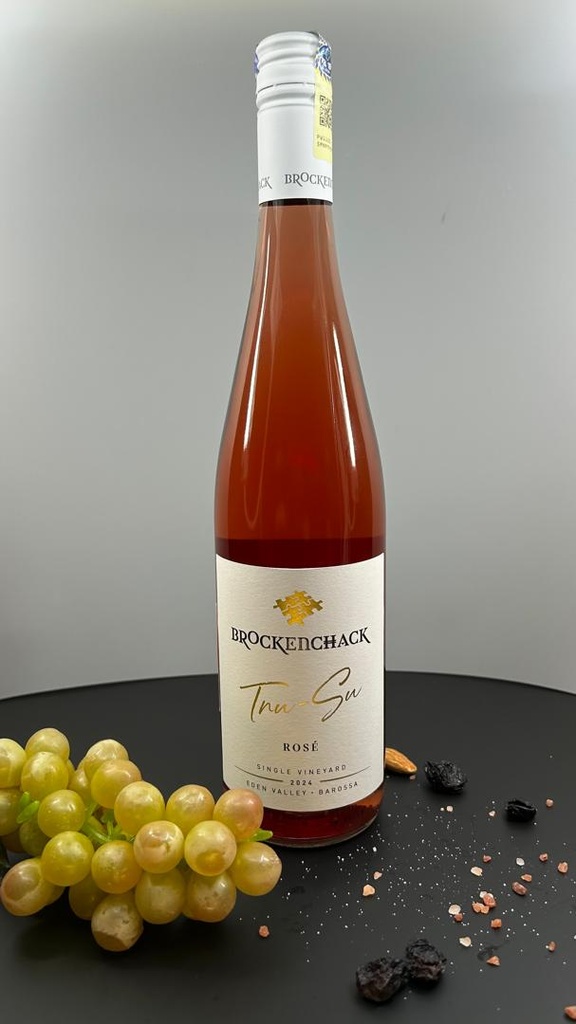Brockenchack 2024 Tru-su Rose
2024 年 Brockenchack Tru-Su Rosé 以西拉为原料,带有草莓、樱桃和玫瑰花瓣的香气,口感清淡爽脆,酸度清新。
| Wine Style: Rose wine |
| County: South Australia |
| Grapes Variety: Grenache |
| Tasting: Light-Bodied |
The Brockenchack 2024 Tru-su Rosé is a wine produced by the Brockenchack Winery, which is located in the renowned Barossa Valley, South Australia. This wine is part of their portfolio and is known for being a vibrant, refreshing rosé with a distinctive character.
Here’s a detailed breakdown of the wine:
1. Grape Varieties:
- Tru-su Rosé is typically made from a blend of red grape varieties, although the exact mix may vary. Commonly used varieties for rosé wines include:
- Grenache: Known for its berry-forward flavors and light, fresh profile. Grenache adds bright red fruit flavors like strawberries and raspberries.
- Syrah/Shiraz: A variety well-suited to warm climates, adding structure, depth, and some spice.
- Cinsault or Mataro (Mourvèdre) might also be included in the blend, adding additional complexity, acidity, and a touch of earthiness.
2. Winemaking Process:
- The grapes are typically hand-harvested, ensuring optimal quality.
- Cold soaking: The grapes undergo a short period of cold soaking to extract delicate color from the skins without over-extracting tannins.
- Pressing: After the soaking period, the grapes are gently pressed to extract juice, which is then fermented at cool temperatures to preserve the fresh fruit flavors and aromas.
- Fermentation: Fermentation is usually done in stainless steel tanks to maintain the purity and vibrancy of the wine.
- No oak aging: Most rosé wines, including this one, are not aged in oak barrels. This keeps the wine fresh and crisp.
3. Tasting Notes:
- Appearance: A pale pink to salmon color, typical of dry rosé wines.
- Aroma: Aromas of fresh red berries (strawberries, raspberries), citrus zest, and subtle floral notes are often present.
- Palate: On the palate, the Tru-su Rosé is light-bodied, crisp, and refreshing with lively acidity. Expect flavors of bright red fruit, like strawberries and cranberries, with hints of citrus and possibly a touch of herbal or spice undertones.
- Finish: The finish is clean and dry, with a refreshing acidity that makes it an excellent choice for pairing with food.
4. Alcohol Content:
- The alcohol content of the 2024 Brockenchack Tru-su Rosé is typically around 12-13%, which is standard for rosé wines.
5. Food Pairing:
- This rosé pairs well with a wide range of light dishes, including:
- Fresh seafood (e.g., oysters, grilled fish)
- Light salads (e.g., with goat cheese or mixed greens)
- Mediterranean cuisine (e.g., tapas, grilled vegetables)
- Charcuterie and soft cheeses
6. Serving Suggestions:
- Best served chilled, around 8–10°C (46–50°F), to preserve the crisp and refreshing qualities.
7. Viticulture and Region:
- Barossa Valley is one of Australia’s most famous wine regions, known for its warm climate, which is ideal for growing a variety of grape varieties, including those used in rosé wines.
- The Tru-su Rosé is produced with an emphasis on sustainable and responsible viticulture practices, focusing on preserving the unique terroir of the Barossa Valley.
8. Brockenchack Winery:
- Brockenchack is a family-owned winery, committed to producing high-quality wines that showcase the best of the Barossa Valley.
- Their vineyards are situated on the slopes of the region’s iconic hills, with soils that are rich in nutrients, which contributes to the distinctive character of their wines.
Serving:
- Temperature: Chill the rosé to around 45-55°F (7-13°C). This is the optimal range to enjoy the fresh, crisp character of a rosé. You want it to be cool enough to emphasize its refreshing qualities but not so cold that it masks the aromas.
- Glassware: Use a tulip-shaped glass or a standard white wine glass with a slightly larger bowl. The shape will help direct the aromas to your nose while allowing the wine to move freely in the glass.
- Pouring: Pour the wine to about one-third of the glass to give it space to breathe and release its aromas.
Decanting:
Typically, rosé wines like the Brockenchack 2024 Tru-su Rosé do not require decanting, as they are intended to be enjoyed fresh and vibrant. Rosé is usually a light and aromatic wine, so decanting is not necessary unless you’re working with a particularly complex or aged rosé (which this one is likely not, given it’s a 2024 vintage).
If you feel the wine is too cold when you open it, you can decant it briefly (about 15-20 minutes) to allow it to warm slightly and open up. However, for the most part, rosé wines are best served directly from the bottle without decanting.
